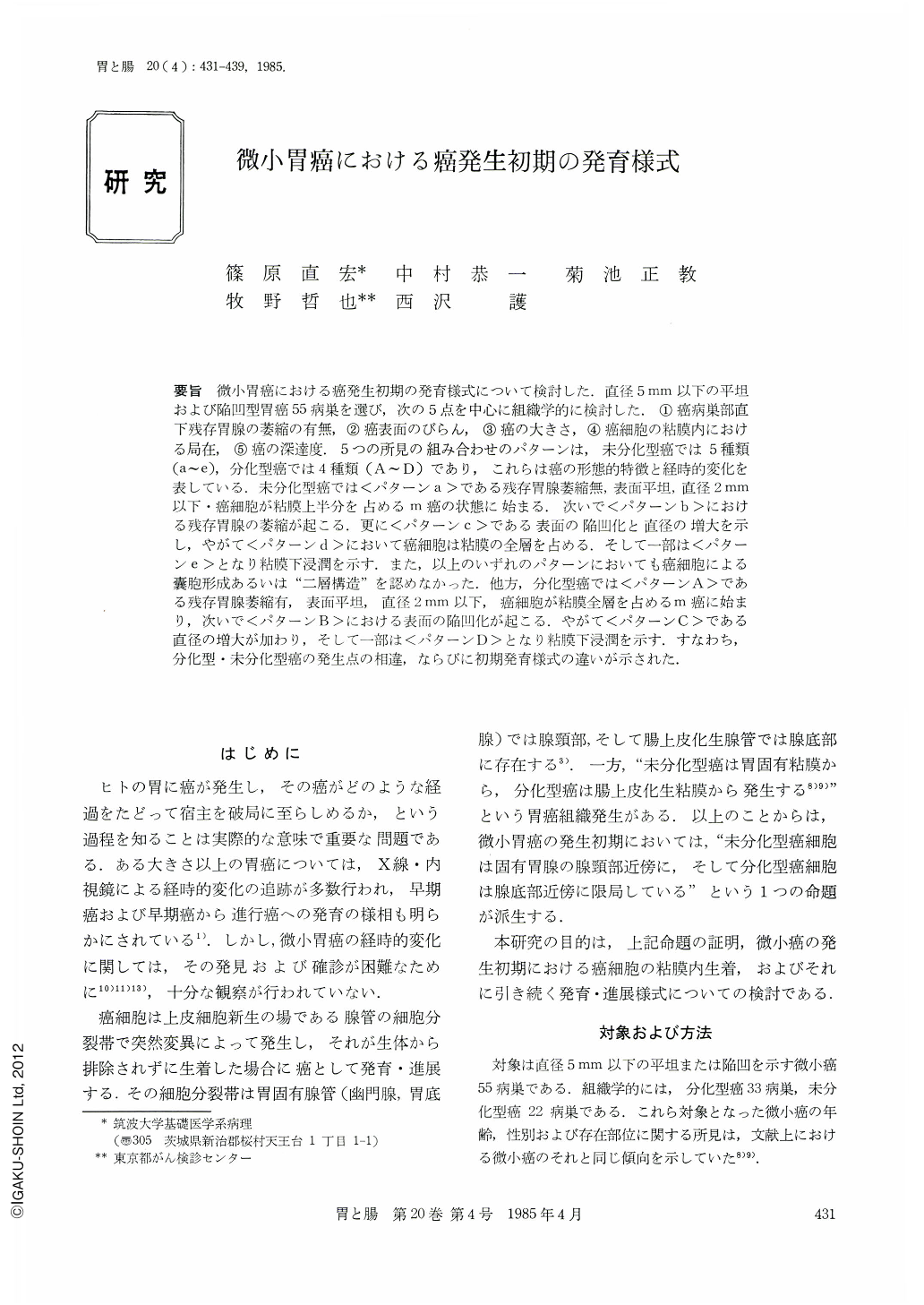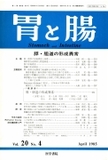Japanese
English
- 有料閲覧
- Abstract 文献概要
- 1ページ目 Look Inside
- サイト内被引用 Cited by
要旨 微小胃癌における癌発生初期の発育様式について検討した.直径5mm以下の平坦および陥凹型胃癌55病巣を選び,次の5点を中心に組織学的に検討した.①癌病巣部直下残存胃腺の萎縮の有無,②癌表面のびらん,③癌の大きさ,④癌細胞の粘膜内における局在,⑤癌の深達度,5つの所見の組み合わせのパターンは,未分化型癌では5種類(a~e),分化型癌では4種類(A~D)であり,これらは癌の形態的特徴と経時的変化を表している.未分化型癌では<パターンa>である残存胃腺萎縮無,表面平坦,直径2mm以下・癌細胞が粘膜上半分を占めるm癌の状態に始まる.次いで<パターンb>における残存胃腺の萎縮が起こる.更に<パターンc>である表面の陥凹化と直径の増大を示し,やがて<パターンd>において癌細胞は粘膜の全層を占める.そして一部は<パターンe>となり粘膜下浸潤を示す,また,以上のいずれのパターンにおいても癌細胞による嚢胞形成あるいは“二層構造”を認めなかった.他方,分化型癌では<パターンA>である残存胃腺萎縮有,表面平坦,直径2mm以下,癌細胞が粘膜全層を占めるm癌に始まり,次いで<パターンB>における表面の陥凹化が起こる.やがて<パターンC>である直径の増大が加わり,そして一部は<パターンD>となり粘膜下浸潤を示す.すなわち,分化型・未分化型癌の発生点の相違,ならびに初期発育様式の違いが示された.
The object of our study is 55 microcarcinomas of the stomach that measured less than 5 mm in the largest diameter and were situated at the gastric mucosa, independently of ulcer and polyp. Of 55 microcarcinomas, 22 were histologically mucocellular or anaplastic adenocarcinomas that belonged to undifferentiated carcinoma and the remaining 33 were tubular adenocarcinomas that belonged to differentiated carcinoma. The 22 undifferentiated carcinomas and the 33 differentiated carcinomas were completely surrounded by the gastric proper mucosa and by metaplastic mucosa of intestinal type, respectively.
These microcarcinomas were histologically examined on the following five findings: 1) Atrophy of the gastric glands just below microcarcinoma, yes or no. 2) Erosion at the surface of microcarcinoma, yes or no. 3) Size of microcarcinoma measuring less than 2 mm in the largest diameter, yes or no. 4) Microcarcinoma occupying the whole mucosa in thickness, yes or no. 5) Microcarcinoma invading the submucosa, yes or no. Thirty-two (the fifth power of two) patterns of the microcarcinomas were logically obtained from combination of the five findings. However, only 5 patterns (Pattern a, b, c, d, e) out of the 32 combinations were practically demonstrated in the 22 undifferentiated carcinomas (Table 2), and 4 patterns (Pattern A, B, C, D) in the 33 differentiated carcinomas (Table 2). These patterns could be put in order by the lapse of time from cancer development, as shown in Figs. 4 and 8. Because, it may be generally considered that a microcarcinoma measuring less than 2 mm in the largest diameter is more incipient in the lapse of time from cancer development than the one measuring more than 3 mm, and a microcarcinoma occupying a part of the mucosa in thickness is more incipient than the one doing the whole mucosa. Further, it may be thought that a microcarcinoma with atrophy or disappearance of the gland just below it exists longer than the one without atrophy or disappearance in the mucosa. Here, the atrophy of glands just below a microcarcinoma means decreasing number of glands in comparison with those of the surrounding mucosa.
The undifferentiated carcinoma having arisen from the neck portion of the ordinary gastric mucosa spread to the propria mucosae around the neck portion of the glands (Pattern a) (Fig. 1). The pre-existing glands just below the microcarcinoma atrophy, with increasing size of microcarcinoma (Pattern b) (Fig. 2), and the superficial surface of the mucosa exposed with cancer cells is depressed with erosion (Pattern c) (Fig. 3). Then, microcarcinoma increases in size with the lapse of time, and it occupies the whole mucosa in thickness (Pattern d), and some of the microcarcinomas measuring approximately 5 mm in the largest diameter invade the submucosa (Pattern e), but submucosal invasion of microcarcinoma is rare. On the other hand, the differentiated carcinoma arisen from the bottom of tubulus consisting of metaplastic epithelium of intestinal type replaces the pre-existing glands and forms new gland, just like budding out (Pattern A) (Figs. 6a and 6b). Then, the differentiated surface carcinoma shows a depression by erosion (Pattern B) and the size of it increases, with the lapse of time (Pattern C) (Fig. 7). Some of the differentiated microcarcinomas invade rarely the submucosa (Pattern D).

Copyright © 1985, Igaku-Shoin Ltd. All rights reserved.


